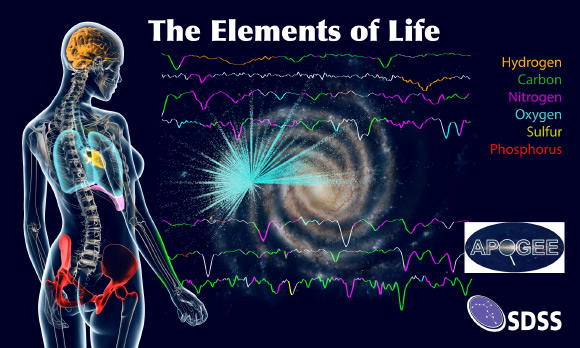At the 229th Meeting of the American Astronomical Society on Jan. 5, 2017, astronomers from the SDSS/APOGEE (Sloan Digital Sky Survey/Apache Point Observatory Galactic Evolution Experiment) project announced results of a new study showing how the abundance of the so-called ‘elements of life’ varies across our Milky Way Galaxy.

The six most common elements of life on Earth (including more than 97% of the mass of a human body) are carbon, hydrogen, nitrogen, oxygen, sulfur and phosphorus. The colors in the spectra show dips, the size of which reveal the amount of these elements in the atmosphere of a star. The human body on the left uses the same color coding to evoke the important role these elements play in different parts of our bodies, from oxygen in our lungs to phosphorous in our bones (although in reality all elements are found all across the body). In the background is an artist’s impression of the Galaxy, with cyan dots to show the APOGEE measurements of the oxygen abundance in different stars; brighter dots indicate higher oxygen abundance. Image credit: Dana Berry / SkyWorks Digital Inc / SDSS.
“It’s a great human interest story that we are now able to map the abundance of all of the major elements found in the human body across hundreds of thousands of stars in our Milky Way,” said study lead author Dr. Jennifer Johnson, of the Ohio State University.
“This allows us to place constraints on when and where in our Galaxy life had the required elements to evolve, a sort temporal Galactic habitable zone.”
“These data will be useful to make progress on understanding galactic evolution, as more and more detailed simulations of the formation of our Galaxy are being made, requiring more complex data for comparison,” added co-author Dr. Jonathan Bird, of Vanderbilt University.
“For the first time, we can now study the distribution of elements across our Galaxy. The elements we measure include the atoms that make up 97% of the mass of the human body,” said co-author Sten Hasselquist, of New Mexico State University.
The new results come from a catalog of more than 150,000 stars. For each star, it includes the amount of each of almost two dozen chemical elements.
The catalog includes all of the CHNOPS elements — carbon, hydrogen, nitrogen, oxygen, phosphorous, and sulfur — known to be the building blocks of all life on Earth.
The astronomers have made these observations using the APOGEE spectrograph on the 2.5-m Sloan Foundation Telescope at Apache Point Observatory, New Mexico.
APOGEE collects light in the near-IR part of the electromagnetic spectrum and disperses it, like a prism, to reveal signatures of different elements in the atmospheres of stars.
The new catalog is already helping astronomers gain a new understanding of the history and structure of our Galaxy, but the catalog also demonstrates a clear human connection to the skies.
As the famous astronomer Carl Sagan said, “we are made of starstuff.”
Many of the atoms which make up your body were created sometime in the distant past inside of stars, and those atoms have made long journeys from those ancient stars to you.
While humans are 65% oxygen by mass, oxygen makes up less than 1% of the mass of all of elements in space.
Stars are mostly hydrogen, but small amounts of heavier elements such as oxygen can be detected in the spectra of stars.
With these new results, the authors have found more of these heavier elements in the inner Milky Way.
Stars in the inner Galaxy are also older, so this means more of the elements of life were synthesized earlier in the inner parts of the Galaxy than in the outer parts.
“While it’s fun to speculate what impact the inner Galaxy’s composition might have on where life pops up, we are much better at understanding the formation of stars in our Galaxy,” the astronomers said.
“Because the processes producing each element occur in specific types of stars and proceed at different rates, they leave specific signatures in the chemical abundance patterns measured by SDSS/APOGEE.”
“This means that SDSS/APOGEE’s new elemental abundance catalog provides data to compare with the predictions made by models of galaxy formation.”
The catalog has been publicly released as part of the Data Release 13 of the SDSS.
_____
Jon A. Holtzman et al. 2017. Chemical Cartography in the Milky Way with SDSS/APOGEE: Multi-element abundances and abundance ratio variations. 229th AAS Meeting, abstract # 216.01
This article is based on a press-release from the Sloan Digital Sky Survey.







